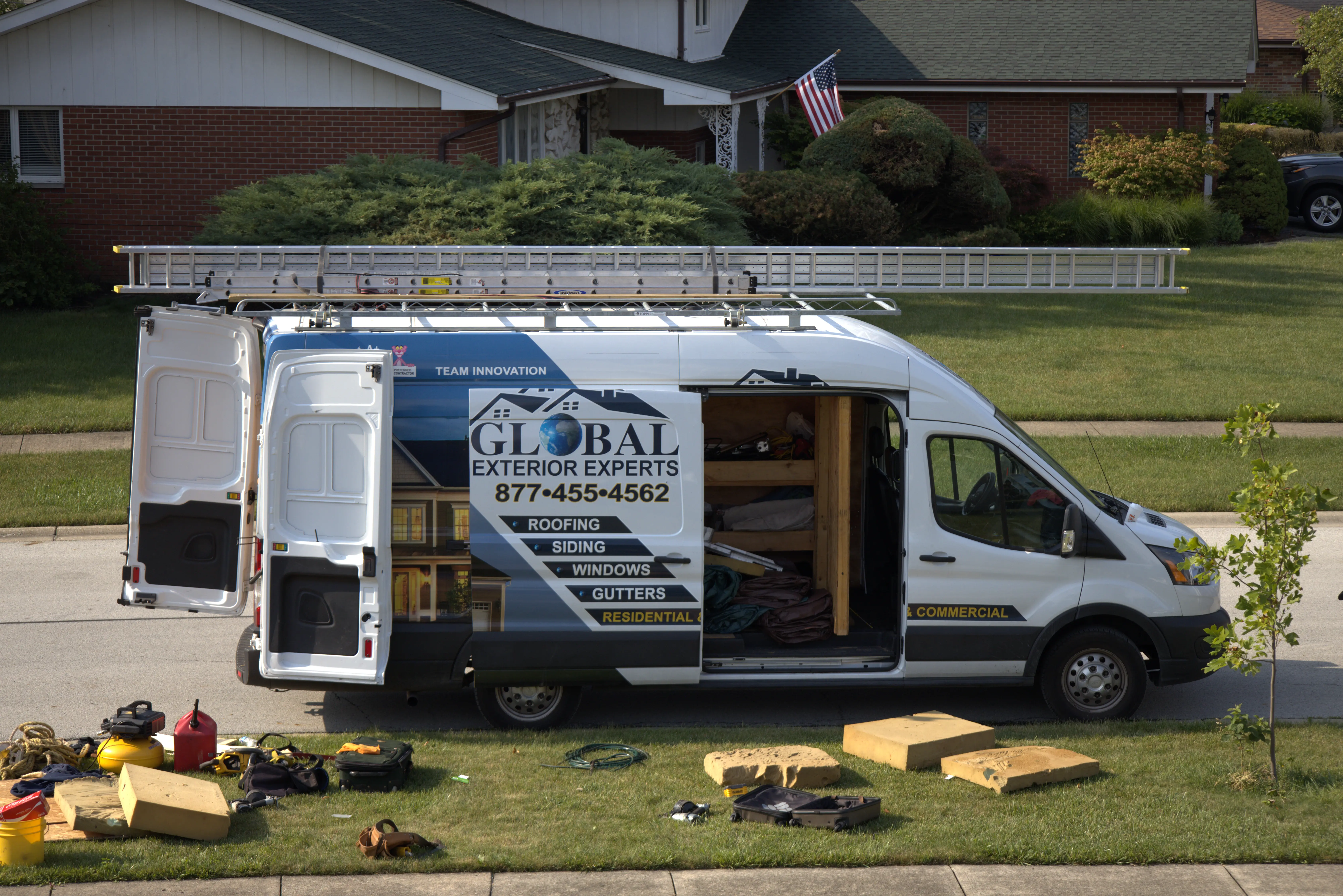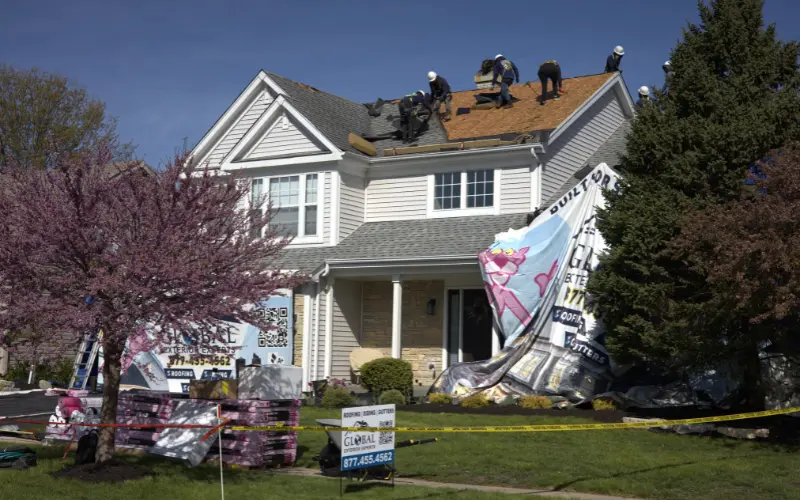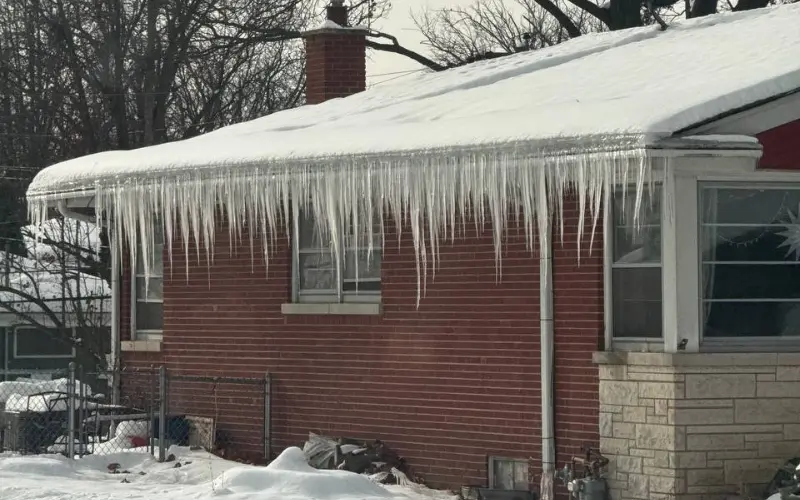Choosing between asphalt shingles and metal roofing comes down to your budget and timeline. Asphalt shingles can cost between $9,000-$17,000 and last 15-25 years while metal roofing can cost $18,000-$32,000 but will last between 40 to 70 years with less maintenance. Both work in Illinois weather when installed by a qualified roofing contractor. Your decision depends on how long you'll own your home and what you value most.
Asphalt Shingles vs. Metal Roofing: What's the Real Difference?

Here's the straight answer: asphalt shingles tend to cost less upfront but require replacing every 15 to 25 years, while metal roofing on the other hand costs roughly double initially but tends to last 40 to 70 years with minimal maintenance. Your choice comes down to budget now versus value over time, and both work fine in our climate if installed correctly.
The roof over your head does more than keep the rain out. It protects your biggest investment, affects your energy bills, and influences your home's value. When it's time for a roof replacement you're looking at one of the most expensive home improvements you'll need to make. So let's break down what separates these two popular options and what that means for your wallet, your comfort, and your future plans.
Understanding Asphalt Shingles: The Traditional Choice

Asphalt shingles have been the go-to roofing material around here for decades. They're made from a fiberglass or organic mat base, coated with asphalt for waterproofing, and topped with ceramic or mineral granules that protect against UV rays and weather.
You've got two main types to consider. Three tab shingles are flat, uniform, and basic. They're the budget option. Architectural (or dimensional) shingles are thicker with varied shapes that create depth and texture. They look better and last longer which is why most homeowners choose them for roof replacement projects.
The main appeal? Cost. Asphalt shingles are the most affordable roofing material you can buy, installation is straightforward, and any experienced roofing contractor knows how to work with them. We can usually finish a standard home in one to three days of course with weather permitting it.
Here's the catch. Asphalt shingles take a beating from our weather and those temperature swings between day and night (especially in spring and fall) cause the shingles to expand and contract leading to cracking. Heavy rain, ice dams in winter, and those random hailstorms we get? They all shorten the lifespan. Algae growth is common in shaded areas too, showing up as dark streaks on your roof.
What Makes Metal Roofing Different

Metal roofing isn't new and it's gained serious popularity in residential settings over the past 20 years. The old perception that metal roofs look industrial or belong only on barns? That's outdated. Modern metal roofing comes in styles that mimic traditional shingles, tiles, even wood shakes.
The most common types you'll see are standing seam panels (those vertical ribs you notice on modern homes), metal shingles that look almost identical to asphalt, and corrugated or ribbed panels. Materials include steel (the most popular), aluminum, zinc, and copper, with steel being the sweet spot for durability and cost.
Metal roofs work by interlocking at the seams or fastening to the roof deck while standing seam systems hide all the fasteners which then means fewer potential leak points. The metal expands and contracts with temperature changes, but the design accounts for this movement.
The biggest selling point is longevity because a properly installed metal roof can last 40 to 70 years! You might never need to replace your roof in your lifetime. They also reflect solar heat instead of absorbing it which helps with cooling costs during our humid summers.
Let's Talk Real Numbers: Cost Breakdown
Alright, here's what you're actually looking at in terms of investment.
For asphalt shingles in our area, expect to pay for an average 2,000-square-foot roof around $9,000 to $17,000. Premium architectural shingles with better warranties push toward the higher end.
Metal roofing on an average 2,000-square-foot roof would cost roughly $18,000 to $32,000. Steel is usually your most economical metal option and while aluminum costs more, it also resists salt corrosion better (relevant if you're near highways that get heavily salted in winter). Copper and zinc are beautiful but push prices significantly higher
Labor accounts for a bigger portion of metal roofing costs because installation requires more skill and takes longer. We're looking at three to seven days for most projects and depending on the roof's complexity.
Of course, none of this comes free from variables. Your roof's pitch matters. Steep roofs cost more to work on safely. Multiple chimneys, skylights, or valleys increase labor time. Local permit costs vary, usually running $150 to $500. And if your roof deck has damage (which you won't know until tear-off), that adds to the bill.
How Long Each One Actually Lasts
This is where the math gets interesting.
Asphalt shingles typically come with warranties ranging from 20 to 30 years, but real-world performance here often falls short. With our freeze-thaw cycles, summer heat, and occasional severe storms, you'll be looking between 15 to 25 years of actual service life. Basic three-tab shingles might only give you 12 to 18 years while architectural shingles usually make it to 20 to 25 years if conditions are favorable.
Do the math on replacement cycles. Install asphalt shingles at age 35, and you're replacing them at 55 and again at 75. Install metal roofing at 35, and you're likely done for life. When you factor in the cost of two or three asphalt roof replacements over the decades, metal starts looking less expensive in the long run.
Also weather resistance differs significantly too. Metal roofing handles high winds better (many systems are rated for 120 to 140 mph gusts). Hail can dent metal but typically won't compromise its function while asphalt shingles crack or lose granules from hail impact, often requiring replacement after severe storms. Ice dams also cause more problems for asphalt shingles because water can back up under them but metal's slick surface helps snow and ice slide off reducing any chance of ice dam formation.
Maintenance: What You're Actually Signing Up For

Here's the thing about maintenance. No roof is maintenance-free, but the workload differs substantially.
Asphalt shingles require more attention and you should inspect them annually. Look for cracked, curled, or missing shingles. After storms, check for wind damage or hail impact. Also algae growth needs treatment every few years in shaded areas which can typically cost $300 to $600 for professional cleaning and preventive treatment. Moss can grow in damp, shaded spots and needs removal before it damages shingles. Small repairs (replacing a few damaged shingles) run $150 to $400 depending on accessibility.
Granule loss is inevitable with asphalt shingles. You'll notice them washing into gutters. When you see bald spots on shingles, that's your roof telling you it's wearing out.
Metal roofing needs less frequent maintenance. Annual inspections are still smart, focusing on fasteners, sealants around penetrations, and checking for any loose panels. Repaint or touch-up might be needed every 15 to 20 years on coated steel, though modern finishes often last longer. The main concern is making sure nothing has compromised the protective coating. Scratches or exposed metal can rust if left unaddressed.
Gutters and valleys need attention regardless of material. Debris buildup causes problems for any roof system.
Energy Efficiency and Your Utility Bills
The energy performance difference is noticeable.
Metal roofing reflects solar radiation rather than absorbing it. In general Light-colored metal roofs can reflect up to 70% of solar energy which means less heat transfers into your attic during summer. This can also reduce cooling costs by 10% to 25% in our hot, humid summers. Attics stay cooler, which means less strain on your AC system.
However (and this matters in our region), metal roofing doesn't provide much insulation value by itself and during winter, it won't keep heat in any better than asphalt. You're still going to have to depend on your insulation for that. Some homeowners notice their heating costs stay about the same or increase slightly with metal roofing in cold climates.
On the other hand, asphalt shingles tend to absorb heat. Dark asphalt roofs can reach 150 degrees or more on sunny summer days and radiating that heat into your attic long after the sun sets. This increases cooling costs but they do provide a tiny bit more insulation value than metal, which can help slightly in winter.
Energy Star rated roofing materials can qualify you for tax credits or utility rebates. Check current programs, as these change periodically.
Installation Process and Timeline
Let's walk through what actually happens.
For asphalt shingle installation, we start by tearing off your old roof (unless it's new construction). We inspect the roof deck for damage, replace any bad plywood, install underlayment and ice/water shield in vulnerable areas, then install drip edge and starter strips. Shingles then go on row by row from bottom to top, ridge cap finishes the peak, and most jobs take one to three days with weather permitting us.
Weather delays happen. We can't install shingles in rain, temperatures below 40 degrees (the adhesive strips won't activate), or high winds. Spring and fall scheduling can get tight because everyone wants their roof done. Summer's busy too, but we have more weather windows.
Metal roofing takes longer and requires more precision. After tear-off and deck inspection, we install a high-quality underlayment (this is critical for metal roofs because you can't just patch it later like shingles). Metal panels or shingles get fastened according to manufacturer specs. Standing seam systems involve clipping panels together and sealing seams. Everything needs to be square and precise because metal doesn't hide mistakes. Most residential jobs take three to seven days.
Noise during installation? Both are loud. You'll hear nail guns and foot traffic either way.
Dealing With Codes, Permits, and Insurance
You need a permit for any roof replacement. Period. The permit process usually takes a few days to a few weeks depending on your local building department's workload. Most roofing contractors handle this for you as part of the job. Inspections happen after installation to verify everything meets code.
Code requirements affect both materials. Fire ratings matter. Ice and water shield requirements vary by county but typically mandate coverage in valleys, eaves (especially for ice dam prevention), and around penetrations. Some municipalities have specific wind uplift requirements after recent storms prompted code updates.
Insurance considerations differ between materials. Metal roofing can lower your homeowner's insurance premium (typically 5% to 15% less) because it's more durable and fire-resistant. Some insurance companies actually prefer metal roofs in areas prone to severe weather or hail. Ask your agent about discounts before deciding.
If you're filing an insurance claim for storm damage, asphalt shingle claims are straightforward because the material's been around forever. Adjusters know what to look for. Metal roofing claims can be trickier. Not all adjusters understand when dented metal affects function versus just aesthetics. Get documentation from your roofing contractor if this comes up.
Climate Matters: What Works Best Here
Our weather throws everything at roofs, from bitter cold and snow in January to extremely hot, & humid summers in July and August. Not to mention spring and fall temperature swings, & random severe thunderstorms with occasional hail. All of this affects performance.
Asphalt shingles handle temperature extremes reasonably well if they're quality materials, but those day-to-night temperature swings cause expansion and contraction that gradually breaks down the asphalt. Winter ice dams are also more problematic for asphalt because water backs up under the shingles and can leak into your home and ruin the roofs decking. On a good note though the granules on asphalt shingles help with UV protection, but our summers still bake them.
Metal roofing actually thrives in varied climates. Snow slides off more easily reducing ice dam risk, the material doesn't deteriorate from freeze-thaw cycles, high winds don't lift properly installed metal panels, hail might dent the surface (cosmetic mostly), but it rarely compromises the roof's function. Summer heat doesn't damage metal, though dark colors can get extremely hot to the touch.
One consideration: metal roofing can be noisy during heavy rain or hail so make sure you use modern installations with solid underlayment and attic insulation minimize this, but some people still notice it more than they would with asphalt.
Making Your Decision: What to Prioritize
Think about your timeline first. How long do you plan to own your home? If you're selling in five to ten years then asphalt shingles might make more sense. You'll recoup some of the cost in curb appeal and home value, but you won't be there long enough to benefit from metal's longevity. If this is your forever home or you're planning to stay 15-plus years, metal roofing's long-term value becomes more attractive.
Budget matters obviously. Can you afford the higher upfront cost of metal? If you're financing, calculate the monthly difference. Sometimes it's smaller than people expect. Don't drain your emergency fund for a metal roof if that money needs to remain accessible. A quality asphalt roof done right will serve you well.
Consider your home's style and neighborhood. Some architectural styles suit metal roofing beautifully (farmhouse, modern, craftsman). Others look better with traditional shingles. Check your neighborhood. If every house has asphalt shingles, a metal roof might stand out (which could be good or bad depending on your perspective and future resale concerns).
Energy savings matter more if you have high cooling costs. If your home has poor attic insulation, fix that first regardless of roofing material. The roof material alone won't solve an insulation problem.
Finally, think about maintenance willingness. If you're someone who stays on top of home maintenance, asphalt shingles are fine. If you prefer set-it-and-forget-it solutions, metal roofing aligns better with that approach.
What to Do Next
Start by getting your current roof inspected if you're not in immediate failure mode. Understanding what you have and what condition it's in helps you plan timing and budget. Some roofing contractors offer free inspections; others charge a nominal fee that's often credited toward any work performed.
Get at least three quotes for any roof replacement project. Make sure quotes include the same scope: full tear-off, underlayment specs, warranty details, and a realistic timeline. The lowest bid isn't always the best value. Check contractor references, licensing, and insurance. Look for established companies with good reputations because your roof's performance depends heavily on installation quality.
Ask about warranties. Manufacturer warranties cover material defects. Workmanship warranties cover installation issues. Get both in writing. Understand what voids warranties (like not maintaining gutters or improper attic ventilation).
Consider financing options if needed. Some roofing contractors offer payment plans. Home equity lines of credit often have lower interest rates than contractor financing. Compare options before committing.
Schedule work during optimal weather windows. Late spring through early fall offers the most reliable weather for installation, but these are also the busiest times. Book early if you're planning a specific timeframe.
The Bottom Line
Both asphalt shingles and metal roofing work well in our area when installed properly by an experienced roofing contractor. Your decision ultimately depends on your budget, how long you plan to stay in your home, and what you value most.
Asphalt shingles give you an affordable, proven solution with straightforward installation and repair. They look traditional, come in countless styles, and any roofing contractor can work with them. You'll likely replace them once or twice during your homeownership, but the upfront savings make them accessible for most budgets.
Metal roofing costs more initially but potentially saves money over the life of your home. It offers superior durability, better energy efficiency in summer, and minimal maintenance. If you're thinking long-term and can handle the higher upfront investment, metal roofing delivers exceptional value.
Neither choice is wrong. Both are legitimate options that thousands of homeowners in our area use successfully. The key is matching the material to your specific situation, budget, and goals. Take time to evaluate your priorities, get multiple professional opinions, and make the decision that aligns with your needs.
Your roof protects everything else. Make the choice that gives you peace of mind and fits your financial reality. That's the right roof for you.

.webp)


